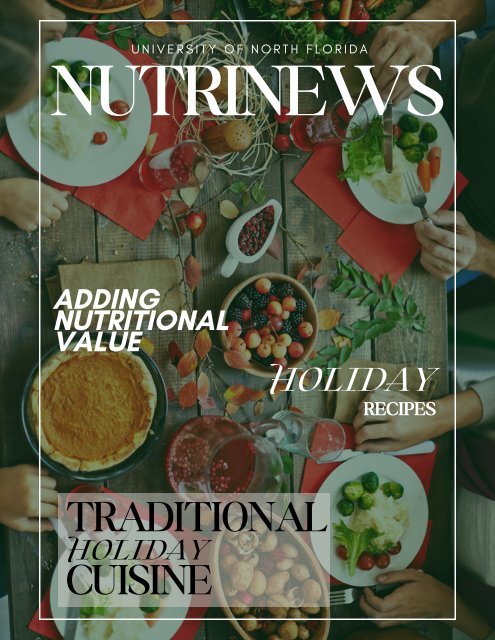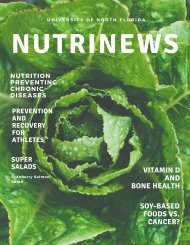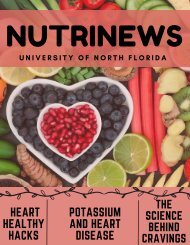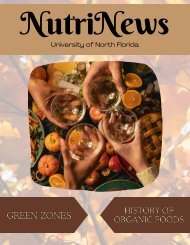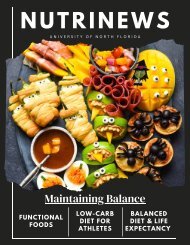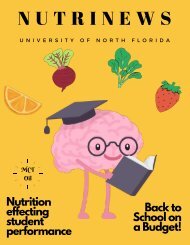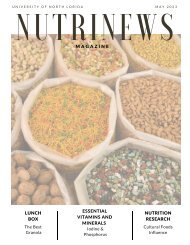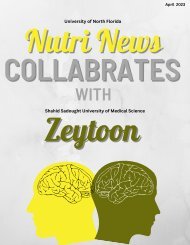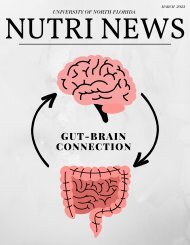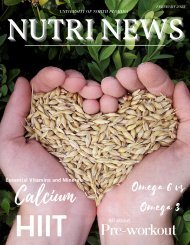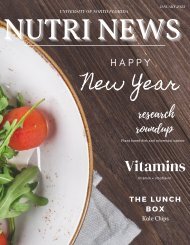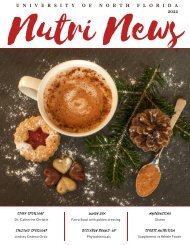December Issue 2023
You also want an ePaper? Increase the reach of your titles
YUMPU automatically turns print PDFs into web optimized ePapers that Google loves.
U N I V E R S I T Y O F N O R T H F L O R I D A<br />
NUTRINEWS<br />
ADDING<br />
NUTRITIONAL<br />
VALUE<br />
HOLIDAY<br />
RECIPES<br />
TRADITIONAL<br />
HOLIDAY<br />
CUISINE
TABLE OF CONTENTS<br />
“Holidays remind us to slow down, breathe, and<br />
appreciate the beauty around us. It’s a time to nourish<br />
our souls and recharge our spirits.”<br />
-GraciousQuotes.com<br />
NUTRITION RESEARCH<br />
Traditional Foods Among Different Holidays Celebrated<br />
FOOD SCIENCE RESEARCH<br />
What are the Effects of L-Tryptophan?<br />
LUNCH BOX<br />
Traditional Foods for Kwanza, Christmas,<br />
Hanukkah/Chanukah<br />
SPORTS NUTRITION<br />
Best Beverage for Optimal Hydration<br />
MONTHLY HACKS<br />
Hacks for Adding Nutritional Value to Holidays Meals<br />
MYTH BUSTING<br />
Debunking “Skipping a Meal Prior to Holiday<br />
Parties/Gatherings”<br />
VITAMINS AND MINERALS<br />
Importance of Vitamin D<br />
STUDENT/SATFF SPOTLIGHT<br />
Staff Interview with Jamisha Leftwich<br />
COMMUNITY/CLUB SPOTLIGHT<br />
Get to Know Local Dietitian Holly Pudwill MS, RDN, LDN,<br />
CEDRD-S<br />
NUTRINEWS STAFF<br />
Get to Know Our Staff!!<br />
04<br />
09<br />
10<br />
14<br />
18<br />
22<br />
26<br />
29<br />
31<br />
33
Writer:<br />
Tavianna Brooks<br />
Nutrition Research<br />
( U . S ) T R A D I T I O N A L<br />
H O L I D A Y F O O D S<br />
The end of the year invites dozens<br />
of holidays to be joyfully<br />
celebrated by the various cultures<br />
across multiple generations.<br />
Holidays, such as Christmas,<br />
have defining characteristics like<br />
colorful lights, adorned trees,<br />
and warm cuisine attributed to<br />
the chilly weather.<br />
However, the origins of<br />
these traditional cuisines<br />
are often overlooked.<br />
Let‘s take a look at the origins<br />
behind the foods eaten at<br />
Christmas, Hanukkah (Chanukah),<br />
and Kwanzaa !
From Goose to<br />
Turkey<br />
T H E B A S I C U . S C H R I S T M A S D I N N E R C O N T A I N S , A T<br />
M I N I M U M , T H E M E A T C E N T E R P I E C E ( S ) , R O A S T E D<br />
R O O T V E G E T A B L E S , M A S H E D P O T A T O E S , A N D<br />
G R A V Y D E R I V E D F R O M T H E B R I T I S H ( 1 ) .<br />
H O W E V E R , R E G I O N S A C R O S S T H E U . S . P U T T H E I R<br />
O W N S P I N O N C H R I S T M A S D I N N E R S , L I K E T H E<br />
U P P E R M I D W E S T I N C O R P O R A T I N G M A S H E D<br />
R U T A B A G A O R O N T H E G U L F C O A S T S E A F O O D<br />
D I S H E S A R E S E R V E D A S A P P E T I Z E R S ( 2 ) . B E F O R E<br />
A M E R I C A N S P E R S O N A L I Z E D T H E I R C H R I S T M A S<br />
F E A S T , T H E I R B A S I C C U I S I N E C H O I C E S W E R E<br />
D E R I V E D F R O M D I F F E R E N T R E G I O N S W O R L D W I D E<br />
T H R O U G H I M M I G R A N T S ( 3 ) .<br />
Originally, the protein of choice to feed a family was a roasted goose because it was the best financial<br />
choice for families who lived off of their livestock, where chickens provided eggs more often than geese<br />
(geese laid eggs seasonally) and cows provided milk (4) Overtime, rural living conditions improved, and<br />
family sizes increased to where the goose was not large enough to feed a family (4). Turkey was the ideal<br />
choice because it was cheaper to raise then other birds and grew to a sufficient size for a family to<br />
consume during the holidays (4). Also, there was a movement to constitute turkeys as an American<br />
holiday custom, pushed by politicians such as Alexander Hamilton declaring “No citizen of the U.S. shall<br />
refrain from turkey on Thanksgiving Day” (3) and New York Senator John Sullivan hosting large banquets<br />
feeding poor immigrants turkey (5). By the 19th century, the turkey became a Christmas staple (1).<br />
H A N U K K A H , A L S O C A L L E D T H E F E S T I V A L O F<br />
L I G H T S , I S C E L E B R A T E D O V E R T H E<br />
C O U R S E O F 8 D A Y S , C O M M E M O R A T I N G<br />
A N A N C I E N T S T O R Y W H E R E J E W I S H P E O P L E<br />
R E C L A I M E D A T E M P L E I N J E R U S A L E M<br />
A F T E R A R E V O L T ( 8 , 9 ) . O N C E I N S I D E T H E<br />
T E M P L E , T H E Y F O U N D E N O U G H O L I V E O I L<br />
S U S P E C T E D T O L I G H T T H E M E N O R A H F O R<br />
A D A Y , H O W E V E R T H E O I L L A S T E D 8 D A Y S<br />
( 8 , 9 ) . H A N U K K A H C E L E B R A T I O N I N C L U D E S<br />
N I G H T L Y M E N O R A H L I G H T I N G , S P E C I A L<br />
P R A Y E R S , A N D F R I E D F O O D S ( 8 , 9 ) .<br />
A Festival of Lights<br />
and Latkes<br />
The dishes are cooked in oil to commemorate the miracle of a small vial of oil lasting 8 days (10). Cuisine<br />
staples of Hanukkah include jelly-filled donut (sufganiyah) and fried potato pancakes, or called latkes, and<br />
jelly donuts (10). Before potato latke, cheese latke was the preferred dish for Hannkuah, particularly in<br />
warmer regions like North Africa or the Middle East (10). Jewish people in colder climates, notably eastern<br />
Europe, had trouble acquiring dairy products.9 Instead they grew potatoes, which was cheaper and<br />
accessible than dairy.9 By the mid 19th century potatoes became a large part of eastern European Jews<br />
diet. German immigrants brought the tradition of potato latkes during Hankkuah to America (9).
Kwanzaa is a week-long U.S holiday that celebrates<br />
African American culture, values, history, family, and community (11,12).<br />
The seven nights of Kwanzaa begin <strong>December</strong> 27th and end January 1st, with<br />
each night highlighting a different principle of Kwanzaa (11,12). The holiday<br />
was created in the mid-1960s by Dr. Maulana Karenga, a black college<br />
professor, in response to the Watts Rebellion, which resulted in 34 deaths,<br />
over a thousand injured, and thousands arrested (11,12). Dr. Karenga created<br />
Kwanzaa to unify the black community (11,12). While there is no traditional<br />
menu, African or African-inspired dishes, such as jambalaya and Jollof rice,<br />
are typically served (13).<br />
R E F E R E N C E S :<br />
1 . G R O C E R 6 . T R A D I T I O N A L C H R I S T M A S D I N N E R S I N A M E R I C A .<br />
M O R T O N W I L L I A M S . P U B L I S H E D D E C E M B E R 1 7 , 2 0 1 8 . A C C E S S E D<br />
O C T O B E R 2 5 , 2 0 2 3 . H T T P : / / M O R T O N W I L L I A M S . C O M / P O S T / T R A D I T I O N A L -<br />
C H R I S T M A S - D I N N E R S - I N - A M E R I C A<br />
2 . U . S E M B A S S Y . A M E R I C A N S C E L E B R A T E C H R I S T M A S W I T H M A N Y<br />
T R A D I T I O N S . U . S . E M B A S S Y I N S W I T Z E R L A N D A N D L I E C H T E N S T E I N .<br />
H T T P S : / / C H . U S E M B A S S Y . G O V / H O L I D A Y - C A L E N D A R / A M E R I C A N S -<br />
C E L E B R A T E - C H R I S T M A S - M A N Y - T R A D I T I O N S /<br />
3 . D E C I C C I O E . W H Y D O W E E A T T U R K E Y O N T H A N K S G I V I N G ? C N B C .<br />
P U B L I S H E D N O V E M B E R 2 4 , 2 0 2 0 .<br />
H T T P S : / / W W W . C N B C . C O M / 2 0 2 0 / 1 1 / 2 4 / W H Y - D O - W E - E A T - T U R K E Y - O N -<br />
T H A N K S G I V I N G - T H E - N E W S - W I T H - S H E P A R D - S M I T H . H T M L<br />
4 . R O T K O V I T Z M . L E A R N A B O U T T H E H I S T O R Y B E H I N D C H R I S T M A S F O O D<br />
T R A D I T I O N S . T H E S P R U C E E A T S . P U B L I S H E D A U G U S T 2 8 , 2 0 2 0 .<br />
H T T P S : / / W W W . T H E S P R U C E E A T S . C O M / T R A D I T I O N A L - C H R I S T M A S -<br />
S P E C I A L T Y - F O O D S - 1 6 6 5 6 4 5<br />
5 . D A V I S O N B . P E R S P E C T I V E | T H E H I D D E N H I S T O R Y O F C H R I S T M A S<br />
D I N N E R . W A S H I N G T O N P O S T .<br />
H T T P S : / / W W W . W A S H I N G T O N P O S T . C O M / N E W S / M A D E - B Y -<br />
H I S T O R Y / W P / 2 0 1 7 / 1 2 / 2 2 / T H E - H I D D E N - H I S T O R Y - O F - C H R I S T M A S -<br />
D I N N E R / . P U B L I S H E D D E C E M B E R 2 2 , 2 0 1 7 .<br />
6 . D I A S E . A B R I E F H I S T O R Y O F E G G N O G . T I M E . P U B L I S H E D D E C E M B E R<br />
2 1 , 2 0 1 1 . H T T P S : / / T I M E . C O M / 3 9 5 7 2 6 5 / H I S T O R Y - O F - E G G N O G /<br />
7 . W I L S O N A . A B R I E F H I S T O R Y O F T H E G I N G E R B R E A D H O U S E . T H E<br />
G U A R D I A N . H T T P S : / / W W W . T H E G U A R D I A N . C O M / T R A V E L / 2 0 1 8 / D E C / 2 2 / A -<br />
B R I E F - H I S T O R Y - O F - T H E - G I N G E R B R E A D - H O U S E . P U B L I S H E D D E C E M B E R<br />
2 2 , 2 0 1 8 .<br />
8 . C H A B A D . O R G . W H A T I S H A N U K K A H ? - I N F O Y O U N E E D A B O U T<br />
C H A N U K A H . @ C H A B A D . P U B L I S H E D D E C E M B E R 1 1 , 2 0 0 3 .<br />
H T T P S : / / W W W . C H A B A D . O R G / H O L I D A Y S / C H A N U K A H / A R T I C L E _ C D O /<br />
A I D / 1 0 2 9 1 1 / J E W I S H / W H A T - I S - H A N U K K A H . H T M<br />
9 . W A X M A N O B . T H E S U R P R I S I N G O R I G I N S O F 5 H A N U K K A H<br />
T R A D I T I O N S . T I M E . P U B L I S H E D D E C E M B E R 1 1 , 2 0 1 7 .<br />
H T T P S : / / T I M E . C O M / 5 0 5 4 8 7 7 / H I S T O R Y - H A N U K K A H - T R A D I T I O N S /<br />
1 0 . K A P U T K , W A S S E R M A N T . G L O B A L H A N U K K A H C U I S I N E : W H A T<br />
W E E A T A N D W H Y . R E F O R M J U D A I S M .<br />
H T T P S : / / R E F O R M J U D A I S M . O R G / R E F O R M - J E W I S H - L I F E / F O O D -<br />
R E C I P E S / G L O B A L - H A N U K K A H - C U I S I N E - W H A T - W E - E A T - A N D - W H Y<br />
1 1 . H I S T O R Y . C O M E D I T O R S . K W A N Z A A . H I S T O R Y . P U B L I S H E D<br />
D E C E M B E R 8 , 2 0 2 1 . A C C E S S E D N O V E M B E R 2 , 2 0 2 3 .<br />
H T T P : / / H I S T O R Y . C O M / T O P I C S / H O L I D A Y S / K W A N Z A A - H I S T O R Y<br />
1 2 . K W A N Z A A . N A T I O N A L M U S E U M O F A F R I C A N A M E R I C A N<br />
H I S T O R Y A N D C U L T U R E .<br />
H T T P S : / / N M A A H C . S I . E D U / K W A N Z A A # : ~ : T E X T = K W A N Z A A % 2 0 W A S % 2<br />
0 C R E A T E D % 2 0 I N % 2 0 1 9 6 6<br />
1 3 . B L U S T E I N A . T H E C U L I N A R Y T R A D I T I O N S O F K W A N Z A A |<br />
I N S T I T U T E O F C U L I N A R Y E D U C A T I O N . W W W . I C E . E D U . P U B L I S H E D<br />
D E C E M B E R 3 0 , 2 0 2 1 . A C C E S S E D N O V E M B E R 2 , 2 0 2 3 .<br />
H T T P S : / / W W W . I C E . E D U / B L O G / T R A D I T I O N A L - K W A N Z A A - F O O D
The Importance of L-Tryptophan<br />
Written By: Sylvia Sacks<br />
L-tryptophan is an essential amino acid that is<br />
necessary for making proteins. It is naturally found in<br />
red meat, poultry, eggs, and dairy.1 L-tryptophan is<br />
important for many organs in the body. It is not made<br />
by the body and must be consumed by the diet.1 L-<br />
tryptophan is an essential amino acid found in various<br />
foods, including turkey.2 Turkey is a popular holiday<br />
dish that many people enjoy. Turkey has great health<br />
benefits, and it can be cooked different ways. It can be<br />
roasted with vegetables or pan roasted with garlic.<br />
Other side dishes during the holidays that include L-<br />
tryptophan are deviled eggs. This is a side dish that<br />
has high levels of protein. There are great recipes<br />
online to follow. Chocolate is also rich in L-tryptophan<br />
and can be turned into a healthy and delicious<br />
dessert.3 Some of the best chocolate recipes include<br />
seven-layer cake and chocolate peppermint brownies.<br />
1. L-Tryptophan: MedlinePlus Supplements. medlineplus.gov.<br />
https://medlineplus.gov/druginfo/natural/326.html#:~:text=L%2DTryptophan%20is%20an%20essential<br />
2. L-tryptophan: Uses and Risks. WebMD. https://www.webmd.com/vitamins-and-supplements/l-tryptophan-uses-and-risks<br />
3. Begum J. Top Foods High in Tryptophan. WebMD. Published November 22, 2022. https://www.webmd.com/diet/foods-high-in-tryptophan
The Lunch Box<br />
Kwanzaa Recipe:<br />
Jerk Chicken<br />
By: Jace Brown<br />
Jerk chicken is a spicy addition to the<br />
Kwanzaa pantry. This recipe originates<br />
from Jamaica and can be dated back to<br />
the 1600s. Escaped slaves ventured into<br />
the Jamaican mountains an invented jerk<br />
by smoking boar meat in covered pits to<br />
avoid detection from the British.<br />
Jerk Chicken:<br />
Marinate 2lb of chicken in onion powder (1 tbsp)<br />
garlic powder (1 tbsp), pepper (1 tbsp), allspice (1<br />
tsp), salt (1 tbsp), paprika (1 tsp), thyme (1tsp),<br />
cayenne (1 tsp), and olive oil (tbsp) overnight.<br />
Grill the chicken until its internal temperature is<br />
165 degrees.<br />
10
The Lunch Box<br />
Christmas:<br />
Herb Turkey<br />
By: Jace Brown<br />
Christmas<br />
After stealing a few of Santa’s cookies you<br />
may want something a little lighter for<br />
Christmas dinner. A traditional Christmas<br />
turkey may be the solution. Roasted turkey<br />
being enjoyed on Christmas first dates to<br />
the 1500s and was enjoyed nearly<br />
exclusively by the exorbitantly wealthy. It<br />
wasn’t until centuries later that the dish<br />
became a cultural Christmas staple.<br />
Herb Turkey<br />
1. After cleaning out a ten lb. turkey, season<br />
it with one tablespoon of rosemary, sage,<br />
thyme, olive oil, salt, and pepper. Add a full<br />
apple into the cavity.<br />
2. Tie the legs with kitchen string and pour<br />
two cups of apple cider into the pan.<br />
3. Wrap the turkey in tin foil and cook until<br />
the internal temperature is 165 degrees,<br />
and the skin is golden brown.<br />
11
The Lunch Box<br />
Hannukkah: Brussel<br />
Sprout Latkes<br />
By: Jace Brown<br />
Hanukkah<br />
Latkes are a potato dish that are a wellknown<br />
staple on the Hanukkah table.<br />
Brussel sprouts are a great green<br />
alternative for a more nutritious option.<br />
Brussel Sprout Latkes<br />
1. Combine 1lb of shredded brussel<br />
sprouts with garlic powder (1 tbsp), onion<br />
powder (1 tbsp), 2 eggs, kosher salt (1<br />
tsp), pepper (1 tsp), and crushed red<br />
pepper (1 tsp).<br />
2. Form the mixture into small pancakes<br />
and coat with flour.<br />
3. Fry the latkes in olive oil until they are<br />
golden brown.<br />
12
<strong>December</strong> 7th - <strong>December</strong> 15th
S P O R T S<br />
N U T R I T I O N<br />
Coconut Water vs. Sports Drinks and Water<br />
for Optimal Hydration and Fuel<br />
Written By: Andrea Butler<br />
Adequate hydration for athletes is important to help them<br />
maintain thermoregulation, account for sodium and water<br />
losses, and ensure oxygen and nutrients are transported to<br />
their muscles during exercise.1 Over the years, sports drinks<br />
have become a traditional hydrating and pre-fuel beverage<br />
within the sports community as it is marketed to provide<br />
electrolytes while replenishing glucose and fluids to allow<br />
athletes to reach optimal performance. However, the recent<br />
trend if desiring an alternative hydration beverage that is<br />
naturally occurring, rich in potassium, sodium, and glucose,<br />
and has fewer calories is the glistening substance of coconut<br />
water.1 Coconut water is one of the top leading plant-based<br />
water beverages for sale worldwide with 250 companies<br />
selling the drink in 20,000+ stores.2<br />
In addition to the isotonic mineral composition found in coconut water that provides hydrating<br />
properties, the flavor and well balanced sugar amount give an enticing quality to the average<br />
consumer and athletes.2 In contrast, traditional sports drinks contains carbohydrates and<br />
electrolytes that is otherwise absent from coconut water.2,3 Since ingesting carbohydrates before<br />
and during exercise provides energy in the form of glucose, an athletes performance and hydration<br />
status increases; thus, the commercial and practical interest of the beverage peaks consumer sales.3<br />
Evidence supporting that coconut water does contain hydration properties that can increase athletic<br />
performance is combative with data that debunks this proposal and favors the sports nutrition<br />
tradition of ingesting sports drinks during exercise. So on the basis of primary research, is it myth or<br />
factual that coconut water offers equal hydration levels compared to sports drinks and water during<br />
continuous exercise?<br />
14
To begin with, O’Brian et al hypothesized that there is no significant difference in performance or physiological<br />
measures between coconut water and a traditional sports drink.4 To test their hypothesis, the researchers<br />
conducted a randomized controlled trial to determine if drinking coconut water compared to a sports drink altered<br />
cycling performance. Nineteen competitive cyclists completed two exercise trials while consuming either a<br />
commercial sports drink or coconut water supplemented with carbohydrates and sodium to match the sports drink.<br />
To formulate an ergogenic effect, the coconut water needed to be augmented with carbohydrates and sodium since<br />
pure coconut water is naturally low is these nutrients. First, each cyclists was required to complete an incremental<br />
test where the researchers measured VO peak and expired air using a calibrated metabolic system to analyze O2 and<br />
CO2 levels. Then, each exercise trial comprised of 90 minutes of pre-load cycling to simulate a typical competition<br />
or training session. The full 90 minutes were broken into 15-minute segments of pre-load exercise, during which the<br />
cyclists drank 2.5 mL of one experimental beverage. Furthermore, the pre-load exercise consisted of five-minute set<br />
high intensity intervals equivalent to 65-70% of the peak power output each cyclists achieved during the<br />
incremental test at 15, 35, 45, 65, and 75 minutes. Five minutes after finishing the pre-load cycling exercise, the<br />
completed a variable gradient, self-paced, 20 km time trial on the Velotron cycle ergometer. Lastly, heart rate, blood<br />
lactate, and glucose were measured at the 30-, 60-, and 85-minute marks for pre-load exercise. The results showed<br />
that at the 60-minute mark for pre-load exercise, both experiment beverages had the highest blood lactate response<br />
of 4 mmol/L. In addition, similar results between beverages were demonstrated at the 30-minute mark with the<br />
highest heart rate of 150 beats per minute. The results for glucose determined that sports drinks have an observable<br />
effect on blood glucose concentration between 30-60 minutes of continuous exercise. Sports drinks produced about<br />
5.6 mmol/L whereas coconut water produced about 5.1-5.4 mmol/L.<br />
Overall findings concluded that although there were recognizable contrasts in terms of physiological and<br />
performance variables, there was no significant difference in the coconut water trial compared to the<br />
sports drink trial.4 In contrast, Peart et al compared hydration markers during submaximal exercise upon<br />
consuming water and coconut water.5 Ten male cyclists completed a 60 minute submaximal cycling trial<br />
followed by a 10-km time trial. The cyclists were randomly assigned a 250 ml drink at the 10–15-minute<br />
mark, 25-30 minute mark, 40-45 minute mark, then drinking as necessary from 55 minutes until the end of<br />
the trial. The researchers measured blood glucose, lactate, heart rate, rate of perceived exertion after each<br />
drink period. The results indicated that coconut water did not significantly improve the cyclists<br />
performance nor the physiological variables compared to regular water. However, subjective differences<br />
in taste between each beverage resulted in a significantly reduced voluntary intake for the coconut water<br />
group. Overall, the researchers discovered that coconut water was not favored by the participants and did<br />
not produce a significant increase in performance, lactate, heart rate, or blood glucose; thus, coconut<br />
water did not provide the greatest benefit for hydration compared to regular water.5<br />
15
Secondly, author Mohammad Fayiz AbuMoh’d designed a randomized controlled trial to determine the influence of<br />
isotonic sports drink ingestion during exercise on endurance capacity and aldosterone response.6 Participants included<br />
twelve main endurance athletes separated into one of three experimental trials – ingesting a sports drink, water, and or<br />
neither option. Each trial had participants run 3000m with an hour recovery and time to administer an exhaustion test as<br />
a way of measuring differences in aldosterone responses before and after the run. The results indicated significant<br />
differences in heart rate which was lower in participate who consumed the sports drink. Furthermore, lower levels of<br />
aldosterone, blood glucose, and sodium were shown in the sports drink group. However, endurance capacity was<br />
significantly greater with the sports drink group compared to water. Thus, isotonic sports drink provide optimal<br />
endurance capacity and maintains aldosterone levels more effectively than hypertonic, hypotonic sports drinks and<br />
water.6 Similarly, to examine the changes in central hydration during continuous exercise, Rowlands et al analyzed the<br />
hydrating effects of hypertonic, isotonic, and hypotonic sports drinks containing carbohydrates and electrolytes<br />
compared to non-carbohydrate-electrolyte drinks and regular water.3 The researchers conducted a meta-analysis<br />
retrieving relevant literature on hypotonic, isotonic, and hypertonic solutions and water. Inclusion studies had to<br />
compare the effect of how the solutions formulated to different osmolality by altering carbohydrate concentrations<br />
and/or electrolyte concentrations. Drinks had to have been consumed orally in all trials with an ingestion rate of ≥ 1 mL<br />
min-1. Hydration was evaluated with plasma volume change from stable resting baseline (central hydration = dPV) with ><br />
1 during exercise samples. Exclusion criteria were studies that had uninterpretable treatment with regard to outcome<br />
measures, subjects dehydrated prior to exercise, or ingested drinks contained protein.<br />
The researchers systematically reviewed randomized crossover trials that<br />
were either double blinded or single blinded. Recruitment included elite<br />
cyclists, runners, triathletes, and recreational active adults. All studies<br />
provided participants with a beverage prior to exercise between 100-813<br />
mL. Thirteen trials supplied servings of about 100-407 mL at 15-min<br />
intervals, six trials at 10 min intervals, six trials at 20 intervals, and two<br />
trials at 30 min intervals. The studies had variables of heat index, average<br />
drink ingestion rate, metabolic rate, total electrolyte, adjusted drink<br />
osmolality, ingested drink osmolality, and total carbohydrate sectioned<br />
into fructose, glucose, and sucrose g/vol. The results showed that metabolic<br />
rate was associated with a lower dPV leading to a larger effect with isotonic<br />
drinks. In addition, increasing the drink ingestion rate lowered the mean<br />
dPV when hypertonic drinks were consumed from the second tertial<br />
Timebin. However, ingesting hypotonic drinks had no impact on dPV early<br />
in exercise. Lastly, the effect of adjusting carbohydrate composition for<br />
intestinal osmolality on dPV was to increase the effect-size difference and<br />
compatibility between each treatment solution. For every 100 mOsM kg-1<br />
increase in ingested osmolality, dPV decreased by -1.1%. Therefore,<br />
adjusting for the effect of carbohydrate digestion reduced dPV to -0.3%<br />
with a 100 mOsM kg-1 increase. Overall, the data gathered from Rowlands<br />
et al demonstrated that hypotonic carbohydrate drinks ingested during<br />
continuous exercise was more likely to maintain central hydration (dPV)<br />
compared to isotonic, hypertonic carbohydrate drinks and noncarbohydrate<br />
drinks.3<br />
16
In conclusion, evidence-based research has proven that while an observable contrast is demonstrated,<br />
there is no significant difference that coconut water is the most effective hydration drink for athletes<br />
compared to a carbohydrate sports drink and regular water. While studies have shown that hypertonic<br />
sports drinks such as Gatorade have advantageous components in the form of such as electrolytes and<br />
carbohydrates, hypotonic sports drinks like Powerade can provide effective results in fluid absorption<br />
leading to increased rehydration for athletes. Water was demonstrated to be equally effective, which<br />
supports the notion that solely relying on sports drinks is not beneficial to increase athletic performance.<br />
Ultimately, athletes should have a balance of fluids according to their sport intensity to stay hydrated and<br />
fueled for submaximal exercise.<br />
References<br />
1. Lalitha Ramaswamy, Zeba Fathima. F. Formulation and Acceptability of Sports Drinks using Fruit Juices and Tender Coconut Water. CORD. 2017;33(1):7-68.<br />
doi:10.37833/cord.v33i1.55<br />
2. Rethinam P, Krishnakumar V. Coconut Water: The Way Forward. In: Coconut Water. Springer International Publishing AG; 2022:499-504. doi:10.1007/978-3-031-<br />
10713-9_12<br />
3. Rowlands DS, Kopetschny BH, Badenhorst CE. The Hydrating Effects of Hypertonic, Isotonic and Hypotonic Sports Drinks and Waters on Central Hydration During<br />
Continuous Exercise: A Systematic Meta-Analysis and Perspective. Sports medicine. 2022;52(2):349-375. doi:10.1007/s40279-021-01558-y<br />
4. O’Brien BJ, Bell LR, Hennessy D, Denham J, Paton CD. Coconut Water: A Sports Drink Alternative? Sports (Basel). <strong>2023</strong>;11(9):183-. doi:10.3390/sports11090183<br />
5. Peart DJ, Hensby A, Shaw MP. Coconut Water Does Not Improve Markers of Hydration During Sub-maximal Exercise and Performance in a Subsequent Time Trial<br />
Compared with Water Alone. International journal of sport nutrition and exercise metabolism. 2017;27(3):279-284. doi:10.1123/ijsnem.2016-0121<br />
6. Mohammad Fayiz AbuMoh’d. Influence of an Isotonic Sports Drink during Exercise and Recovery on Subsequent Endurance Capacity and Aldosterone Response in<br />
the Heat in Well-Trained Endurance Athletes. Sport Mont. 2020;18(2):25-31. doi:10.26773/smj.200617<br />
17
HOLIDAY<br />
HACKS<br />
A D D I N G N U T R I T I O N A L<br />
V A L U E T O H O L I D A Y<br />
M E A L S W H I L E S T I L L<br />
E N J O Y I N G A L L T H E<br />
T R A D I T I O N S<br />
B y S o p h i a H a r r i s<br />
The holidays are the time of year when people gather<br />
with family and friends to spend some quality time<br />
together. While this time of year can be very exciting, it<br />
can also be difficult for those who want to<br />
simultaneously enjoy traditional holiday foods and<br />
maintain a healthy lifestyle. With some tweaking, it is<br />
possible to make beloved holiday recipes healthier so<br />
that people don’t have to sacrifice their favorite holiday<br />
treats that they look forward to.<br />
One way to create a healthier holiday is to add foods<br />
rich in vitamin D to your menu. During the cooler<br />
months, it can be hard to get enough vitamin D, so<br />
eating mushrooms, fortified milk, fortified milk<br />
alternatives, and eggs can build up your levels of this<br />
vital vitamin. 1 Incorporating more vegetables can give<br />
your holiday menu a boost in nutrients as well. There<br />
are already many classic recipes that include<br />
vegetables, such as sweet potatoes, squash, and green<br />
beans, that you can continue to serve at dinner parties.<br />
18
You can also add different vegetables to the<br />
menu to spice things up and provide a wider<br />
range of nutrients. Root vegetables are a great<br />
option, as they are in season around this time<br />
and can be a good source of complex<br />
carbohydrates, fiber, carotenoids, vitamin C, and<br />
other nutrients. 1 Examples of foods that fall<br />
under this category include parsnips, beets,<br />
carrots, turnips, and rutabagas. 1 Leafy greens<br />
like kale, spinach, and collard greens are also in<br />
season in some areas, 1 so they can be<br />
another option. These greens provide iron,<br />
calcium, potassium, and vitamin K. 1 Adding<br />
herbs and spices can not only make dishes<br />
more nutritious, but they make foods more<br />
flavorful as well. You can, for instance, add<br />
basil, oregano, thyme, and chives to homemade<br />
salad dressings, and basil and thyme can be<br />
great additions to stuffing. You can also spice up<br />
your vegetables with some parsley, chervil,<br />
fennel, coriander, dill, mint, sage, thyme, and<br />
rosemary. You could even add cinnamon and<br />
nutmeg to cranberry sauce. 1<br />
Another way to eat healthier is to reduce the<br />
amount of sodium you consume. While sodium<br />
has many health benefits, such as regulating<br />
blood sugar, muscle function, and the nervous<br />
system, it can cause harm in excess. 1 For<br />
example, too much sodium can lead to health<br />
problems like high blood pressure. 1<br />
Unfortunately, many of the ingredients used to<br />
make classic holiday meals tend to have large<br />
amounts of sodium. To avoid the excess<br />
sodium, make your own broth/stock or buy<br />
reduced/sodium-free broths at the store, pick<br />
fresh or dried spices and herbs instead of<br />
packaged blends, choose fresh and frozen<br />
vegetables over canned ones (if you go for<br />
canned, rinse them before using), choose<br />
unsalted foods like nuts for snacking, and make<br />
your own biscuits, croutons, salad dressings,<br />
gravy, and stuffing. 1 Adding more whole grains<br />
to your holiday dinner can also help you eat<br />
healthier and get more micronutrients and fiber.<br />
1 Many whole grains, such as brown rice, farro,<br />
barley, bulgur, millet, and quinoa, can be<br />
served as sides. 1<br />
19
Switching ingredients for healthier alternatives<br />
can help add more nutrients to your holiday<br />
meals too. Some swaps you can make to<br />
recipes include replacing butter or cream with<br />
broth when making mashed potatoes, using<br />
yogurt in desserts, creamy sauces, dressings,<br />
mashed potatoes, casseroles, and butternut<br />
squash soup in place of sour cream, and<br />
replacing butter with olive oil. 1 Other ways to<br />
cut back on unhealthy fats and sugar include<br />
replacing half of the butter in a recipe with<br />
unsweetened applesauce, mashed bananas, or<br />
prune puree, reducing the amount of sugar in a<br />
recipe by 1/3 or ½ and adding spices<br />
(cinnamon, cloves, and allspice) and extracts<br />
(almond, vanilla, and wintergreen) to enhance<br />
the flavor, and cutting the amount of cheese in a<br />
recipe in half. 2 Choosing healthier cooking<br />
methods, such as broiling, grilling, steaming,<br />
and baking, can help make your holiday meals<br />
healthier as well. 2<br />
You can, for instance, broil your fish, meat, and<br />
vegetables instead of frying them, and use<br />
nonstick pans to avoid adding oil. Also, instead<br />
of basting in oil, you can try using vinegar or fruit<br />
juices. 2<br />
If you want to get inspiration or don’t know what<br />
to make for the upcoming holiday dinner, you<br />
can always visit the USDA’s website and look<br />
up healthy recipes for any holiday that you<br />
celebrate. 3 The USDA’s website includes<br />
recipes that are affordable and that meet the<br />
MyPlate criteria, so you know you are making<br />
meals that have greater nutritional value. As you<br />
can see, there are many ways to make healthier<br />
dishes for the upcoming holiday season. I hope<br />
that this article helps those who want to prepare<br />
their favorite holiday treats and eat healthy at<br />
the same time.<br />
20<br />
References<br />
1. MacPherson R. Boost your holiday meals with these 9 nutrition tips. Verywell Fit. November 16, 2022. Accessed October 16, <strong>2023</strong>.<br />
https://www.verywellfit.com/ways-to-make-your-holiday-meal-more-nutritious-5208789.<br />
2. Williams E. Tips for making your holiday meals healthier. Michigan State University. November 7, 2022. Accessed October 16, <strong>2023</strong>.<br />
https://www.canr.msu.edu/news/tips_for_making_your_holiday_healthier.<br />
3. Healthy, thrifty holiday menus. U.S. Department of Agriculture. Accessed October 16, <strong>2023</strong>. https://snaped.fns.usda.gov/resources/nutritioneducation-materials/healthy-thrifty-holiday-menus.
MYTH BUSTING<br />
SKIPPING MEALS<br />
BEFORE THE<br />
HOLIDAYS<br />
THESIS AND PURPOSE<br />
As the holiday seasons<br />
approach, many people are<br />
getting ready to have friends<br />
and family over for a fun holiday<br />
party or meal, usually with an<br />
abundance of decadent foods<br />
and treats. Some people believe<br />
skipping meals during the<br />
holidays is a beneficial strategy<br />
to combat weight gain and still<br />
allow them to indulge in their<br />
WHAT FOOD DOES FOR YOU<br />
favorite treats. However, this<br />
can do more harm than good.<br />
Skipping meals can cause<br />
serious health problems such<br />
as anxiety, depression, low<br />
energy, and decreased<br />
enjoyment in eating, among<br />
others. This article shows how<br />
skipping meals is detrimental<br />
to your body, mental health,<br />
and long-term health.<br />
Glucose is the main type of energy source found in the blood. It<br />
comes from the food we eat. When people are hungry, blood<br />
glucose becomes low and leave us feeling sluggish since the brain<br />
runs off glucose.1 When you eat a sensible and healthy meal, it<br />
benefits your muscles, immunity, bone strength, lowers risk of<br />
heart disease and type 2 diabetes, helps the digestive system, and<br />
aids in achieving and maintaining a healthy weight.2 As you can<br />
see, food provides much more than just nutrition and fuel. So<br />
what happens when you skip a meal?<br />
WHY WE GET HUNGRY<br />
BY: KATIE ALJIIAN<br />
22<br />
When you get hungry, it is because<br />
your body is releasing hormones that<br />
trigger these feelings. “Migration<br />
Motor Complex (MMC) is regulated by<br />
a hormone called motilin. Motilincontrolled<br />
contractions cause<br />
rumbling in our stomachs and<br />
coincide with hunger pains in<br />
humans.”3
WHY WE GET HUNGRY CONT’D<br />
When you get hungry, it is because your body is releasing hormones<br />
that trigger these feelings. “Migration Motor Complex (MMC) is<br />
regulated by a hormone called motilin. Motilin-controlled<br />
contractions cause rumbling in our stomachs and coincide with<br />
hunger pains in humans.”3<br />
BODY’S REACTION TO SKIPPING A MEAL<br />
When you abstain from eating,<br />
you begin to feel tired and slow.<br />
Your hypothalamus is the part<br />
of the brain that is responsible<br />
for regulating your body’s<br />
homeostasis. When you skip a<br />
meal, your hypothalamus must<br />
work extra hard to keep your<br />
body regulated.4 Not only is<br />
your body working overtime to<br />
offset this imbalance, it’s also<br />
literally starving. This means<br />
the body is deficient in fuel and<br />
nutrients.<br />
A common misconception is<br />
that skipping a meal will help<br />
you become thinner... here’s<br />
why it’s not that easy. When<br />
you’re hungry, your body's<br />
cortisol levels (stress hormone)<br />
go up, causing your body to hold<br />
onto every little sliver of<br />
nutrition it gets.4 Cortisol can<br />
also cause you to feel anxious<br />
and depressed.1 Once that<br />
nutrient supply is dried up, your<br />
body will go into ketosis, a state<br />
your body enters when it begins<br />
to burn fat.<br />
As you continue to abstain from<br />
eating, your body begins<br />
breaking down your muscles,<br />
resulting in a loss of muscle<br />
mass. When you begin eating<br />
normally again, your body will<br />
revert to its normal weight.<br />
People will often overeat or<br />
gorge on holiday food and end<br />
up gaining more weight than<br />
they started with.<br />
Eating should never feel<br />
stressful. This mentality can<br />
put you at risk of developing an<br />
eating disorder or losing the<br />
enjoyment in food. Constantly<br />
worrying about food and what is<br />
“bad” for you can become<br />
obsessive and lead to bulimia or<br />
anorexia.5 To prevent these<br />
occurrences from happening, it<br />
could be helpful to practice<br />
mindful and intuitive eating.5<br />
This involves listening to your<br />
body’s natural hunger and<br />
fullness cues. Your body will tell<br />
you what it needs. This can be a<br />
great way to stay healthy.<br />
23
HOW TO PREVENT YOURSELF<br />
FROM SKIPPING MEALS<br />
It can be hard to eat if you are constantly finding yourself<br />
unsatisfied. There are a few tricks that might help. For example, try<br />
making a simple plan of what you want to eat that week. It can be as<br />
easy as going on Pinterest or searching specific types of meals or<br />
snacks you might enjoy.7 I always keep a snack on me in case I am<br />
too busy to eat at that exact moment.<br />
It's not a substitute for a meal, but it can hold me over until I am<br />
able to eat.7 If you have a hectic schedule and sometimes forget to<br />
eat, you can try to set a reminder on your phone or find an<br />
accountability buddy to help remind you.7 Making meals can be<br />
challenging, so finding easy recipes online could always be handy. If<br />
you don’t like to cook, try to find a way to make it fun to bring back<br />
some of the joy of eating. You could put music on to keep you<br />
entertained or talk to a family member over the phone.7 You could<br />
also make a special holiday meal you know you will love to eat.<br />
CONCLUSION<br />
Food is the fuel for life. It gives us sustenance so we can go about<br />
our day. Without it, our bodies react negatively in selfpreservation,<br />
which may lead to health implications. This holiday<br />
season, when you join family and friends for dinner, don’t forget to<br />
get to eat prior to the occasion. You don’t want to be snappy in<br />
front of your family just because your hangry. Not eating can affect<br />
your mind and its chemicals. Treat your food as medicine and enjoy<br />
that comforting meal this holiday season.<br />
24<br />
WORKS CITED:<br />
1. WICKS L.8 SCARY THINGS THAT COULD HAPPEN TO YOUR BODY WHEN YOU SKIP MEALS. EATING<br />
WELL. <strong>2023</strong>. 7561431. SEPTEMBER 15, <strong>2023</strong>. WHAT HAPPENS WHEN YOU DON'T EAT?<br />
(EATINGWELL.COM)<br />
2. BENEFITS OF HEALTHY EATING. CDC. 2021. BENEFITS OF HEALTHY EATING | NUTRITION | DNPAO |<br />
CDC<br />
3. HEWINGS-MARTIN Y. WHY DO WE GET HUNGRY? MNT. 2017. THE SCIENCE OF HUNGER<br />
EXPLAINED (MEDICALNEWSTODAY.COM). ACCESSED OCTOBER 31, 2017.<br />
4. YENKO J. FAT. UNDER EATING & STOMACH FAT. LIVESTRONG. HOW DOES NOT EATING AFFECT THE<br />
BRAIN? | LIVESTRONG<br />
5. OLSSON R. 5 THINGS THAT HAPPEN TO YOUR BODY WHEN YOU SKIP MEALS. BANNERHEALTH.<br />
OCTOBER 2022. HERE’S WHAT HAPPENS WHEN YOU SKIP MEALS | BANNER HEALTH<br />
6. VULELICH L. STOP SKIPPING MEALS, YOUR MENTAL HEALTH DEPENDS ON IT. CNET. FEBRUARY 23, <strong>2023</strong>. STOP SKIPPING MEALS. YOUR MENTAL<br />
HEALTH DEPENDS ON IT - CNET
Nurturing Your Health<br />
Through Winter: The<br />
Importance of Vitamin D<br />
Written By:<br />
Madi Cashman<br />
As winter starts with its chillier and shorter days, many of us take comfort in cozy indoor activities.<br />
Whether it's huddling by a warm fireplace with a good book or putting on a snug pair of socks, the<br />
season presents opportunities to embrace comfort and relaxation. However, there's a potential<br />
downside to these extended periods spent indoors which is lower levels of Vitamin D.1<br />
Vitamin D, a crucial nutrient for overall health, becomes a concern during the winter months due to<br />
reduced sunlight exposure. With less sunshine and limited outdoor activity, our bodies absorb less<br />
of this vital vitamin through the skin.1 Fortunately, there are multiple ways to fight the effects of<br />
Vitamin D deficiency and maintain health even when the sun isn't shining brightly.<br />
One of the approaches to maintaining healthy Vitamin D levels is through your diet. Surprisingly,<br />
you<br />
may already be consuming some Vitamin D-rich foods without even realizing it. Just as oranges are<br />
known for their Vitamin C content and meat is a source of protein, several foods provide Vitamin<br />
D.2 These include:<br />
1. Salmon<br />
2. Cheese<br />
3. Fortified milk<br />
4. Mushrooms<br />
5. Egg Yolks<br />
Additionally, certain food products, such as milk and some cereals, are fortified with<br />
Vitamin D to help individuals meet their daily requirements.2 Incorporating these Vitamin<br />
D-rich foods into your diet during the winter months is an effective strategy to support<br />
your health.<br />
26
Eating Vitamin D-rich foods<br />
One of the approaches to maintaining healthy Vitamin D levels is<br />
through your diet. Surprisingly, you may already be consuming<br />
some Vitamin D-rich foods without even realizing it. Just as<br />
oranges are known for their Vitamin C content and meat is a<br />
source of protein, several foods provide Vitamin D.2 These<br />
include:<br />
1. Salmon<br />
2. Cheese<br />
3. Fortified milk<br />
4. Mushrooms<br />
5. Egg Yolks<br />
Additionally, certain food products, such as milk and some cereals,<br />
are fortified with Vitamin D to help individuals meet their daily<br />
requirements.2 Incorporating these Vitamin D-rich foods into your<br />
diet during the winter months is an effective strategy to support<br />
your health.<br />
Over-the-counter Supplements<br />
Another method to maintain your daily Vitamin D intake is through over-the-counter<br />
supplements, readily available at your local drugstore or pharmacy. These supplements often<br />
come in two forms: D2 and D3. Both D2 and D3 can elevate your Vitamin D levels during the<br />
winter months, but studies suggest that D3 may be more effective. 2 Your choice may also<br />
depend on the source of the supplement. D2 is derived from yeast and plants, while D3 is<br />
typically derived from animal fat. 2 Both are suitable options, and the selection often depends<br />
on individual preferences.<br />
27
Prescription-Strength Vitamin D<br />
While over-the-counter options are suitable for most, some<br />
individuals may require prescription- strength Vitamin D<br />
supplements, especially during the winter or when at risk<br />
of deficiency. Various factors can influence your risk for<br />
Vitamin D deficiency, including:<br />
1. Age: Older individuals are at a higher risk due to decreased<br />
skin efficiency in producing Vitamin D.2<br />
2. Weight: Obesity can slow the absorption of Vitamin D,<br />
increasing the risk of deficiency.2<br />
3. Health History: Conditions such as celiac disease, kidney disease, liver disease, Crohn's<br />
disease, or osteoporosis often lead to lower Vitamin D levels.2<br />
4. Medications: Some medications can affect the body's utilization and absorption of Vitamin<br />
D.2<br />
5. Skin Tone: Individuals with darker skin tones are less efficient at using sunlight to produce<br />
Vitamin D, increasing their susceptibility to deficiency.2<br />
To determine your Vitamin D levels and the risks that may come with them, an easy blood<br />
test can be<br />
ordered during your annual visit with your primary care provider. These routine tests are<br />
crucial in identifying health concerns, including low Vitamin D levels. Once your levels are<br />
assessed, your primary care provider can guide you in choosing the most suitable method of<br />
supplementation based on your health needs.<br />
Maintaining Vitamin D Levels Year-Round<br />
While the colder months often bring the concern of lower Vitamin D levels, it's important to<br />
understand that this nutrients’ significance extends beyond winter. It's a year-round<br />
consideration for maintaining your overall health and bone health. Although you can't stop<br />
the arrival of colder seasons, you have several options to maintain your Vitamin D levels<br />
throughout the year.<br />
By consistently ensuring you receive your daily dose of Vitamin D, you contribute to the wellbeing<br />
of your bones and overall health.2 With multiple approaches available, you can protect<br />
your Vitamin D<br />
levels even during the winter months when the sun is less generous with its rays.<br />
28<br />
References<br />
1.Cantorna, M. T. (2020, January 19). Why getting enough vitamin D in wintertime is so important. The<br />
Washington Post. https://www.washingtonpost.com/health/why-getting-enough-vitamin-d-inwintertime-is-so-important/2020/01/17/c3598082-3875-11ea-9541-9107303481a4_story.html#<br />
2.Chestercountyhospital.org. (n.d.). https://www.chestercountyhospital.org/news/health-elivingblog/2022/december/deck-the-halls-with-vitamin-d-avoiding-those-winter-blues
S T A F F S P O T L I G H T<br />
Dr. Jamisha Leftwich<br />
D r . J a m i s h a L e f t w i c h s e r v e s a s a n i n s t r u c t o r i n t h e D e p a r t m e n t o f<br />
N u t r i t i o n a n d D i e t e t i c s a n d t h e P r o g r a m D i r e c t o r f o r t h e I n t e g r a t e d<br />
F u t u r e G r a d u a t e P r o g r a m i n N u t r i t i o n a n d D i e t e t i c s . H e r r e s e a r c h<br />
f o c u s a r e a s i n c l u d e c o m m u n i t y n u t r i t i o n , n u t r i t i o n e d u c a t i o n a n d<br />
c o u n s e l i n g p r o g r a m m i n g , m a t e r n a l , i n f a n t , c h i l d h e a l t h a n d n u t r i t i o n ,<br />
a n d l a c t a t i o n .<br />
By: Kaley Morrissey<br />
B A C K G R O U N D : P E R S O N A L A N D P R O F E S S I O N A L<br />
Years in the field:<br />
She has been in the field of dietetics for<br />
10 years.<br />
What brought her to UNF?<br />
She is a three-time graduate with her<br />
bachelor’s, master’s, and doctorate<br />
degrees.<br />
What are her roles/titles here - what classes<br />
do you teach?<br />
She is a community dietitian. She has<br />
taught Community Nutrition, Social and<br />
Cultural Influences on Nutrition, Nutrition<br />
Counseling, Nutrition Education, Food<br />
Service Management 1, Clinical Practices,<br />
and Nutrition Through a Lifespan. These<br />
are both graduate and undergraduatelevel<br />
courses.<br />
W H A T D O Y O U L I K E B E S T A B O U T B E I N G A P R O F E S S O R ?<br />
“Connecting with the students.” She says that she loves talking<br />
to them about their journey of wanting to become a dietitian<br />
and “helping them with those light-bulb moments.”<br />
29
W H A T M A D E Y O U W A N T T O<br />
P U R S U E T H E C A R E E R / D E G R E E<br />
T H A T Y O U H A V E ?<br />
Her dad was diagnosed with type 2<br />
diabetes when she was in high school.<br />
She would go with her dad to meet with<br />
his dietitian to discuss the foods and<br />
lifestyle choices he needed to make with<br />
his new diagnosis. She said that opened<br />
her eyes to how food can affect your<br />
health and help to manage a disease.<br />
So, after meeting with her dad’s dietitian,<br />
she knew that was what she wanted to<br />
do.<br />
D I D Y O U A L W A Y S K N O W T H A T<br />
Y O U W A N T E D T O B E A P A R T O F A<br />
U N I V E R S I T Y O R A P R O F E S S O R ?<br />
She did not always know that she<br />
wanted to be a professor. When she went<br />
into community dietetics, she was the<br />
lead preceptor and created all of the<br />
assignments and rotations for the<br />
students. “I noticed a gap in their<br />
education levels when they got to me.” At<br />
that point, she realized that she wanted<br />
to be on the educational side of all of this<br />
and help the students and get rid of<br />
those gaps.<br />
30<br />
W H A T D O Y O U F E E L H A S<br />
B E E N T H E B I G G E S T<br />
C H A L L E N G E I N T H I S F I E L D ?<br />
“Lack of diversity.” She said that because<br />
of the lack of diversity in this field, there is<br />
a lack of services being provided to<br />
patients. With the lack of diversity,<br />
patients may struggle to feel that<br />
connection and share those similarities<br />
with their dietitians.<br />
W H A T A D V I C E D O Y O U H A V E<br />
F O R T H O S E C U R R E N T L Y<br />
P U R S U I N G A D E G R E E I N<br />
D I E T E T I C S ?<br />
“The field of dietetics and nutrition is a<br />
very rewarding and fulfilling career.” She<br />
says that if you are passionate about<br />
nutrition and learning the science behind<br />
food then this is a good career choice for<br />
you. As for studying, she says that it can<br />
be hard and intense. However, being<br />
able to have time management and<br />
being able to justify your evidence for<br />
your conclusion is key. Many people do<br />
not realize that this is a science-based<br />
major.<br />
C A N Y O U T E L L U S A F U N F A C T<br />
A B O U T Y O U R S E L F T H A T M A N Y<br />
P E O P L E M A Y N O T K N O W ?<br />
In every country and/or state she visits,<br />
she takes a cooking class. She has taken<br />
classes in places like Italy, Belgium, Brazil,<br />
France, and more. She is also a Zumba<br />
instructor.
ABOUT<br />
Holly Pudwell,<br />
MS, RDN, LDN, CEDRD-S<br />
Background<br />
Years in the field?<br />
16 years<br />
What are your roles/ titles?<br />
Registered Dietitian in private practice<br />
and residential/PHP.<br />
Anything else you would like to share about<br />
your background?<br />
Treating eating disorders has been my<br />
goal since high school and I have been<br />
working with this population since<br />
college.<br />
What is your favorite part of your role/job?<br />
Seeing the healing that is possible is the<br />
greatest reward!<br />
What made you want to pursue the career/degree<br />
that you have?<br />
From the first time I learned about eating<br />
disorders in my high school AP Psych class. I<br />
realized how many people around had or<br />
were struggling with one. I thought,<br />
“someone should really do something about<br />
that” and then thought, “why not me?”. In<br />
doing so I got to marry my endless<br />
fascination with the intricate way God has<br />
designed the human body with my desire to<br />
help others.<br />
Do you or the BYB ministry have any food<br />
related holiday traditions?<br />
At BYB we strive to pay attention to<br />
details that make a difference, that<br />
make our patients feel at ease and wellloved.<br />
Holidays are no exception so we<br />
work to serve special meals, hand<br />
stockings,and have fun activities.<br />
What do you feel has been the biggest<br />
challenge in your field?<br />
There are several! One major one is the<br />
lack of education on eating disorders in<br />
medicine and nutrition, both are<br />
deplorably diet-centric.<br />
Did you always have an interest in<br />
nutrition/dietetics/public health/volunteering?<br />
I became fascinated with how the body works<br />
in a high school health class and wanted to<br />
pursue learning more and use that knowledge<br />
to helps others.<br />
Any closing advice or fun facts?<br />
I think our world would look drastically different<br />
if we all knew that the perfect, loving, allknowing<br />
God of the universe made each of us<br />
on purpose, exactly as we are, and loves us<br />
unconditionally. We do not need to look any<br />
certain way or jump through any particular<br />
hoops to earn his acceptance and love and his<br />
is the one that ultimately counts.<br />
31
<strong>December</strong> 26th -<br />
January 1st
Meet the Team<br />
Editor in Chief<br />
Delaney<br />
Tindal<br />
Co-Editor in Chief<br />
Leigh Anne<br />
Vanzant<br />
Head Publisher<br />
Ashley<br />
Demmery<br />
Media Manager<br />
Maddie<br />
Levenson<br />
Faculty Advisor<br />
Dr. Alireza<br />
Jahan-Mihan<br />
Treasurer<br />
Grace<br />
Scoggins<br />
33
Meet the Team<br />
Secretary Flyer Creator Publisher<br />
Izzy<br />
Kaitlin<br />
Bailey<br />
Vicario Fredrick Taylor<br />
Publisher<br />
Carole<br />
Stringfield<br />
Publisher<br />
Mary Elizabeth<br />
Hayes<br />
Publisher<br />
Sarah<br />
Turner<br />
34
Meet the Team<br />
Publisher Editor Editor<br />
Katelyn<br />
Giovanna<br />
Cagyan<br />
Faria<br />
Hailey<br />
Pond<br />
Editor<br />
Sophia<br />
Sardella<br />
Editor<br />
Ali<br />
Walker<br />
Editor<br />
Marshall<br />
Thompson<br />
35
Meet the Team<br />
Writer<br />
Andrea<br />
Butler<br />
Writer<br />
Tavianna<br />
Brooks<br />
Writer<br />
Madison<br />
Cashman<br />
Writer<br />
Katie<br />
Aljian<br />
Writer<br />
Jace<br />
Brown<br />
Writer<br />
Sophia<br />
Harris<br />
36
Meet the Team<br />
Interviewer<br />
Julianna<br />
Gilbert<br />
Interviewer<br />
Kaley<br />
Morrissey<br />
37


